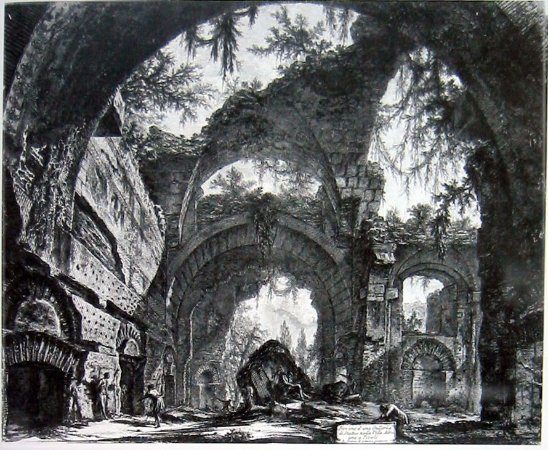{:it}Mostra di Giovanni Battista Piranesi a Pesaro : ” Il sogno della classicità”
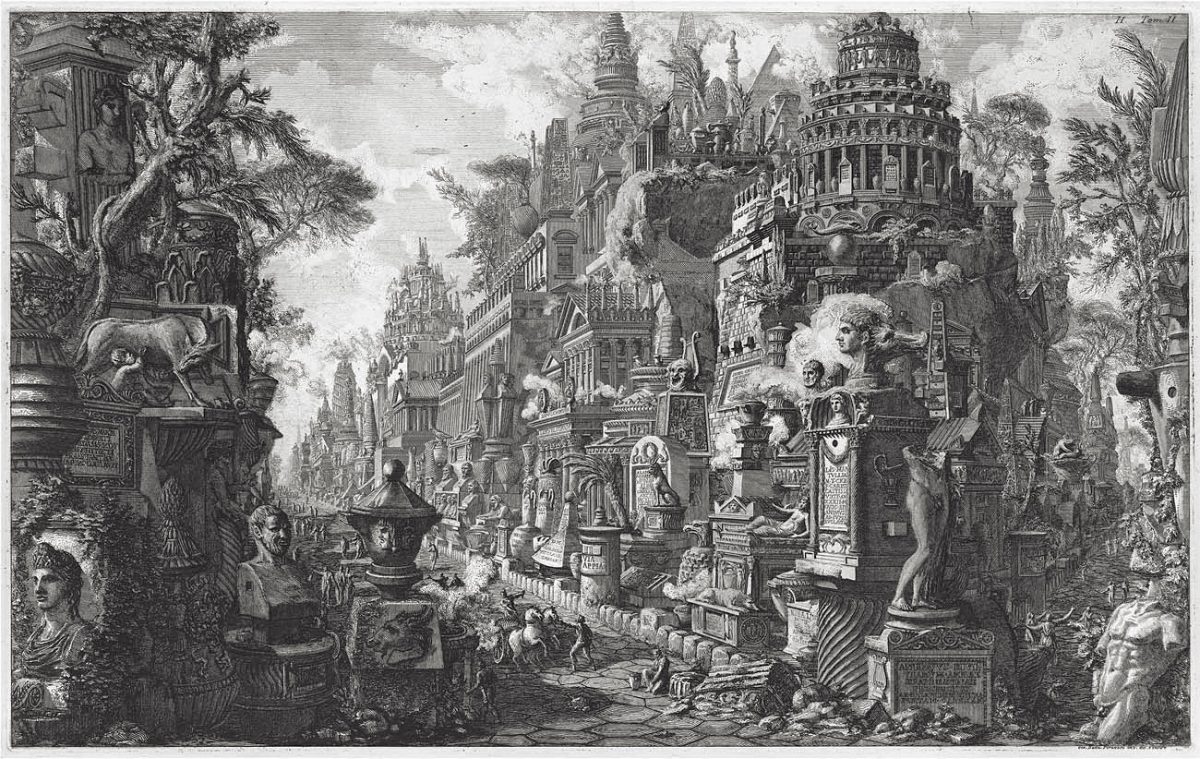 “ La mente nera di Piranesi” dice in suo passo Victor Hugo. Le opere del grande incisore del Settecento , interprete della bellezza tragica di Roma, possono essere ammirate fino all’8 Aprile 2018 nelle sale di Palazzo Mosca, Musei Civici di Pesaro.
“ La mente nera di Piranesi” dice in suo passo Victor Hugo. Le opere del grande incisore del Settecento , interprete della bellezza tragica di Roma, possono essere ammirate fino all’8 Aprile 2018 nelle sale di Palazzo Mosca, Musei Civici di Pesaro.
Un viaggio nel tempo e nello spazio attraverso le rovine della città antica incise da colui che si definiva “ architectus venitianus” ma che , una volta giunto nella capitale, fù completamente rapito da quelle visioni romantiche di templi e statue antiche semi abbandonate nei campi verso cui nutriva un sentimento tutto goethiano di rendersi utile preservandone il ricordo. Le sue opere, tuttavia , estremamente suggestive e romantiche, sembrano avvertirci di un pericolo sempre imminente e quindi appaiono anche funeste, per non dire inquietanti.
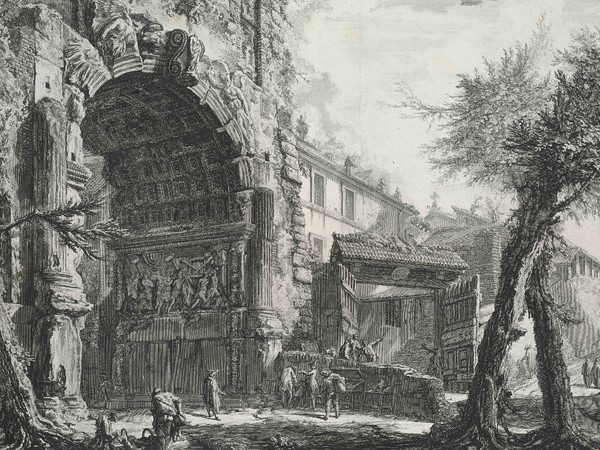
Tra le rovine si scorgono sciancati, orribili gobbi che hanno l’aria di essere senza fissa dimora se non abitanti di quei relitti di pietra e mattoni degno ambiente per quegli accattoni, e ancora teschi e sarcofaghi, cani che si mordono e si spulciano, pecore che pascolano, stracci tra i cespugli, quel che resta insomma di un impero che dominava il mondo, per evidenziare quella condizione umana che muta continuamente e nel cui destino sono tutti ascritti, persino i potenti.
Il senso di decadenza riguarda anche se stesso, la sua vita di architetto sempre in cerca di lavoro, antiquario e incisore, costretto a diversi mestieri in una Roma intrisa di papismo, forte del suo potere che si concentra attorno ad esso e che non lascia scampo, il messaggio è denso di avvertimenti, la ruota che gira in fondo riguarda tutti, anche chi è detentore del potere.
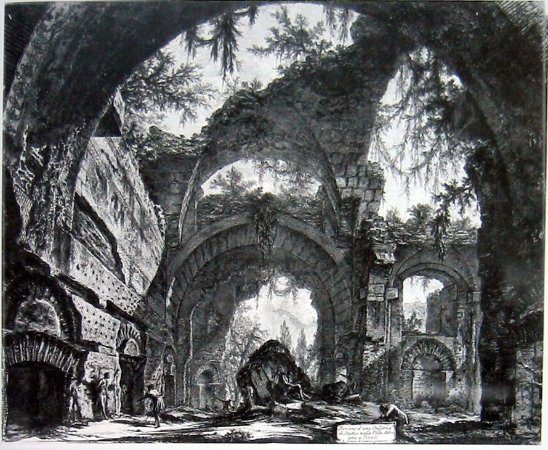
Nella mostra di Pesaro scorrono tra le diverse stanze del museo le opere dell’artista architetto, alcune ammirabili a misura d’uomo, altre purtroppo collocate troppo in alto da impedirne una corretta ed attenta visione, ed è veramente un peccato.
Vale comunque una visita, non fosse altro che per ammirare il video sulle famose “ Carceri d’invenzione” realizzato da Gregoire Dupont per la Fondazione Giorgio Cini di Venezia, dove si viene assorbiti dal suo mondo immaginifico che rimanda ai Piombi veneziani e ad un’angoscia tutta metastasiana della condizione umana; l’incubo dal quale non si può uscire, l’Inferno , il Giudizio o il Dies Irae caro ai romanzi gotici a seguire.
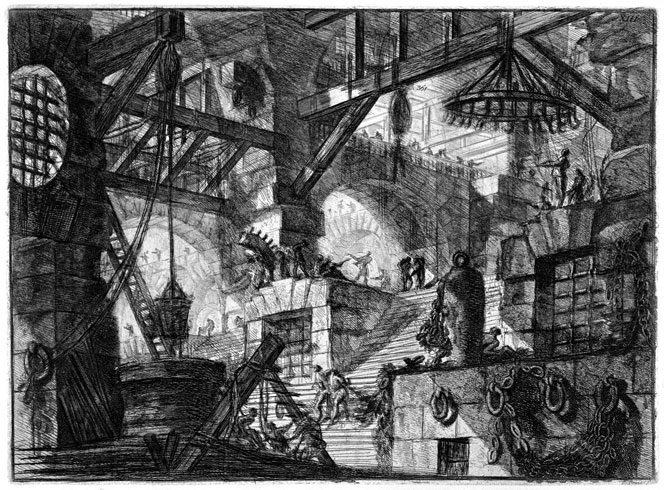 Immergendosi nei suoi androni, salendo quelle scale, sembra di entrare nelle cavità della mente di questo artista logorato dalla fatica, appassionato e incurante della sua salute, che si cibava solo di riso freddo durante i lunghi soggiorni nella campagna romana infestata dalla malaria.
Immergendosi nei suoi androni, salendo quelle scale, sembra di entrare nelle cavità della mente di questo artista logorato dalla fatica, appassionato e incurante della sua salute, che si cibava solo di riso freddo durante i lunghi soggiorni nella campagna romana infestata dalla malaria.
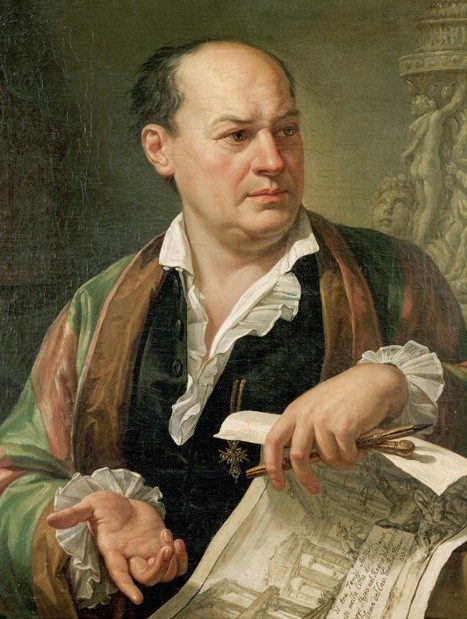
Il genio del Piranesi si esplica nella sua maestria e nella capacità divulgativa , sposando la tecnica della litografia è stato in grado di stampare centinaia di copie dei suoi disegni frutto di un lavoro immenso, incidendoli su lastre di zinco, senza tuttavia alterarne la bellezza. In questo senso l’arte di Piranesi fù veramente moderna e capace di lasciare il “segno”, che è poi la precondizione per l’immortalità
“ Giambattista Piranesi, il sogno della classicità” – 8 dicembre 2017 , 8 aprile 2018. Pesaro, Palazzo Mosca Musei Civici , piazza Toschi Mosca 29– www.pesaromusei.it{:}{:en}
“The black brain of Piranesi” wrote Victor Hugo. The works of the great engraver of the Eighteenth century and commentator of the tragic beauty of Rome can be seen at Palazzo Mosca, Municipal Museums (Musei Civici) in Pesaro until April, 8 2018.
 A time and space travel through the ancient Roman ruins, engraved by the artist who used to describe himself as “architectus venetianus (latin for Venetian architect)”, but it was when he moved to Rome that he was hit by romantic visions of the ancient temples and statues almost abandoned across the fields. Those ruins raised a Goethean feeling in him, i.e. the usefulness of keeping their memory. His works were extremely suggestive and romantic, it seems like they warn of a forthcoming danger, so that they appear even menacing, or disturbing.
A time and space travel through the ancient Roman ruins, engraved by the artist who used to describe himself as “architectus venetianus (latin for Venetian architect)”, but it was when he moved to Rome that he was hit by romantic visions of the ancient temples and statues almost abandoned across the fields. Those ruins raised a Goethean feeling in him, i.e. the usefulness of keeping their memory. His works were extremely suggestive and romantic, it seems like they warn of a forthcoming danger, so that they appear even menacing, or disturbing.
 Among the ruins you can catch sight of cripple and horrible hunch-backed figures, that look like homeless or maybe their home is the stone and brick ruin; the right place for those beggars; some skulls and sarcophaguses, biting and delousing dogs, grazing sheep, rags on the bushes, finally what is left of an empire that used to rule the world. The scenery highlights the always-changing human condition, in which everyone – including the mighty people – accepts destiny.
Among the ruins you can catch sight of cripple and horrible hunch-backed figures, that look like homeless or maybe their home is the stone and brick ruin; the right place for those beggars; some skulls and sarcophaguses, biting and delousing dogs, grazing sheep, rags on the bushes, finally what is left of an empire that used to rule the world. The scenery highlights the always-changing human condition, in which everyone – including the mighty people – accepts destiny.
 The feeling of decay applies also for the artist himself, his architect’s life always looking for a job, antique dealer and engraver, forced to change several jobs in a time where Rome was ruled by powerful popes, strong and with no way out. The message is dense in warnings; the metaphorical and turning circle on the background refers to everyone’s lives, even to mighty people.
The feeling of decay applies also for the artist himself, his architect’s life always looking for a job, antique dealer and engraver, forced to change several jobs in a time where Rome was ruled by powerful popes, strong and with no way out. The message is dense in warnings; the metaphorical and turning circle on the background refers to everyone’s lives, even to mighty people.
At Pesaro’s exhibition you can look at the works of the architect and man of Arts, some of them are people-oriented while others are located too high for a proper and careful viewing, and that is a real pity.
It is well worth a visit, if only for the video about the famous “Imaginary Prisons” made by Gregoire Dupont for the Venetian Fondazione Giorgio Cini, where you are absorbed by his imaginary world that reminds of The Venetian Leads (Piombi is an ancient prison in Venice) and a Metastasian angst of the human condition. It’s like a nightmare you cannot get out of, an Inferno that never ends, the Judgement or the “Dies Irae (latin for The Last Judgement)” that would later become a leitmotif in Gothic novels. Losing yourself in those entrance halls, climbing the stairs, it seems like entering the holes of the brain of this artist who was worn out by struggles, but still passionate and unconcerned about his own health, his main dish was cold rise during the long stay in the malarial Roman countryside.
 Piranesi’s genius shows in his expertise and educational talent, he used the lithographic technique to print hundreds of copies of his own drawings, engraved on zinc slabs, keeping intact their original beauty. In this case, Piranesi’s art was modern and able to leave a “sign”, that is actually the precondition to immortality.
Piranesi’s genius shows in his expertise and educational talent, he used the lithographic technique to print hundreds of copies of his own drawings, engraved on zinc slabs, keeping intact their original beauty. In this case, Piranesi’s art was modern and able to leave a “sign”, that is actually the precondition to immortality.
Visit the Exhibition “Giambattista Piranesi, il sogno della classicità” from December, 8 2017 until April, 8 2018 in the City of Pesaro, Piazza Toschi Mosca 29, at Palazzo Mosca, Municipal Museums (Musei Civici), www.pesaromusei.it{:}

